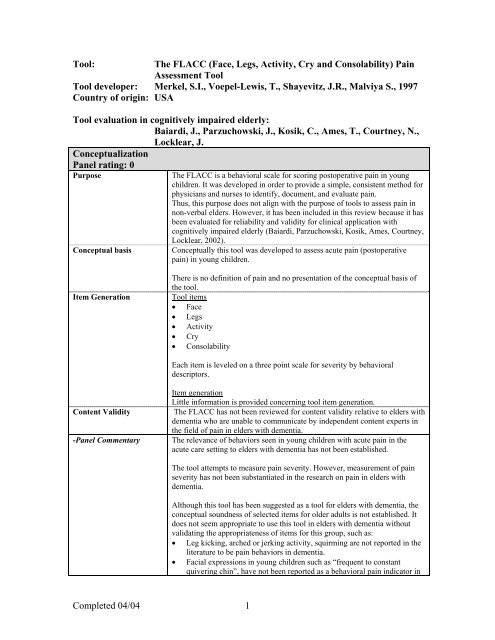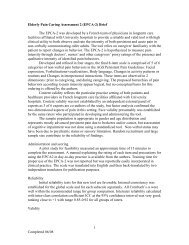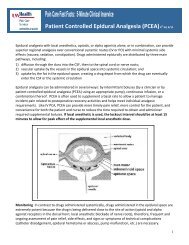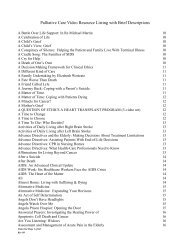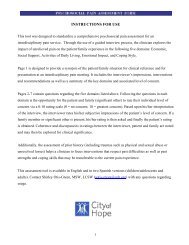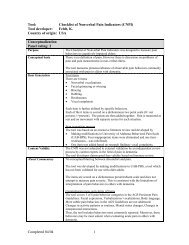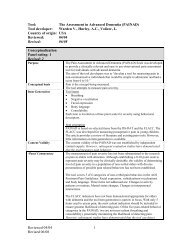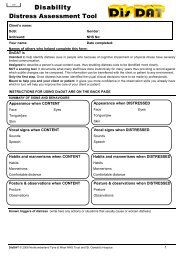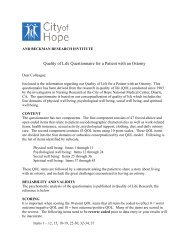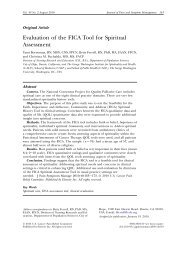Completed 04/04 1 Tool: The FLACC (Face, Legs, Activity, Cry and ...
Completed 04/04 1 Tool: The FLACC (Face, Legs, Activity, Cry and ...
Completed 04/04 1 Tool: The FLACC (Face, Legs, Activity, Cry and ...
- No tags were found...
You also want an ePaper? Increase the reach of your titles
YUMPU automatically turns print PDFs into web optimized ePapers that Google loves.
<strong>Tool</strong>:<strong>The</strong> <strong>FLACC</strong> (<strong>Face</strong>, <strong>Legs</strong>, <strong>Activity</strong>, <strong>Cry</strong> <strong>and</strong> Consolability) PainAssessment <strong>Tool</strong><strong>Tool</strong> developer: Merkel, S.I., Voepel-Lewis, T., Shayevitz, J.R., Malviya S., 1997Country of origin: USA<strong>Tool</strong> evaluation in cognitively impaired elderly:Baiardi, J., Parzuchowski, J., Kosik, C., Ames, T., Courtney, N.,Locklear, J.ConceptualizationPanel rating: 0PurposeConceptual basis<strong>The</strong> <strong>FLACC</strong> is a behavioral scale for scoring postoperative pain in youngchildren. It was developed in order to provide a simple, consistent method forphysicians <strong>and</strong> nurses to identify, document, <strong>and</strong> evaluate pain.Thus, this purpose does not align with the purpose of tools to assess pain innon-verbal elders. However, it has been included in this review because it hasbeen evaluated for reliability <strong>and</strong> validity for clinical application withcognitively impaired elderly (Baiardi, Parzuchowski, Kosik, Ames, Courtney,Locklear, 2002).Conceptually this tool was developed to assess acute pain (postoperativepain) in young children.Item Generation<strong>The</strong>re is no definition of pain <strong>and</strong> no presentation of the conceptual basis ofthe tool.<strong>Tool</strong> items• <strong>Face</strong>• <strong>Legs</strong>• <strong>Activity</strong>• <strong>Cry</strong>• ConsolabilityEach item is leveled on a three point scale for severity by behavioraldescriptors.Content Validity-Panel CommentaryItem generationLittle information is provided concerning tool item generation.<strong>The</strong> <strong>FLACC</strong> has not been reviewed for content validity relative to elders withdementia who are unable to communicate by independent content experts inthe field of pain in elders with dementia.<strong>The</strong> relevance of behaviors seen in young children with acute pain in theacute care setting to elders with dementia has not been established.<strong>The</strong> tool attempts to measure pain severity. However, measurement of painseverity has not been substantiated in the research on pain in elders withdementia.Although this tool has been suggested as a tool for elders with dementia, theconceptual soundness of selected items for older adults is not established. Itdoes not seem appropriate to use this tool in elders with dementia withoutvalidating the appropriateness of items for this group, such as:• Leg kicking, arched or jerking activity, squirming are not reported in theliterature to be pain behaviors in dementia.• Facial expressions in young children such as “frequent to constantquivering chin”, have not been reported as a behavioral pain indicator in<strong>Completed</strong> <strong>04</strong>/<strong>04</strong> 1
SubjectsPanel rating: 1Subjects-Panel CommentaryAdministration, Scoring, FeasibilityPanel rating: 0Administration,Scoring,Feasibility-Panel Commentaryelders.• Consolability is not a pain behavior, but a response to an intervention.<strong>The</strong> behavioral categories on <strong>The</strong> <strong>FLACC</strong> do not fit well with the sixbehavioral categories in the AGS Persistent Pain Guideline.Three behavioral categories are not addressed in <strong>The</strong> <strong>FLACC</strong>: Changes ininterpersonal interactions, Changes in activity patterns or routines, Mentalstatus changes. Thus, <strong>The</strong> <strong>FLACC</strong> does not have content validity whenjudged against the behaviors in the AGS Guideline.<strong>The</strong> <strong>FLACC</strong> was tested in long-term care in a sample of 6 cognitivelyimpaired elders with documented history of late-stage dementia (Baiardi etal., 2002).Subjects had an identified source of pain, in majority musculoskeletal, <strong>and</strong>were currently receiving a non-steroidal anti-inflammatory agent suggestingthey had persistent pain.Age: 83 years average (±11.0).Gender: Majority of subjects were female.<strong>The</strong> focus on long term care setting is clearly identified. <strong>The</strong> residents appearto have persistent pain. However, the <strong>FLACC</strong> was developed for assessmentof acute pain in young children in the acute care setting.<strong>The</strong>se residents are identified as having documented late-stage dementia.However, the method for identifying the level of dementia is not identified.<strong>The</strong>re is no information on ethnic/racial diversity.Using 5 subjects per tool item as a rule of thumb, a minimum sample size of25 subjects (5 items x 5 subjects) would be needed. Thus, this sample of 6subjects is insufficient for tool evaluation.Each of 5 items of pain behaviors is scored on a 3 point ordinal scale for painseverity.Total scores range from 0 to 10 points, a maximum of 2 points per item.<strong>The</strong> method of administration used in the study on elders is not described.Scoring procedures are clearly described. However, interpretation of toolscore is unclear.ReliabilityPanel rating: 1Internal consistencyInterrater reliabilityTest-retest reliability-Panel commentaryClinical utility: Information on clinical utility in elders is unknown.No data on internal consistency are availableThree trained research observers independently recorded pain assessmentsusing either the <strong>FLACC</strong> or Modified UAB Pain Assessment <strong>Tool</strong>. Interraterreliability is based on a total of 69 valid <strong>FLACC</strong> observations <strong>and</strong> 56 validUAB observations from only 6 patients. <strong>FLACC</strong> observations: Kappa statistic= .4<strong>04</strong> or less.Poor agreement was noted between observers when scoring cognitivelyimpaired elderly with persistent pain using the <strong>FLACC</strong>. Factors thought to becontributing to poor reliability included limited facial expressions, verbalcomplaints, <strong>and</strong> movement. <strong>The</strong> researchers conclude that the <strong>FLACC</strong> is not auseful pain assessment tool for cognitively impaired elderly.No test-retest or intra-rater reliability of the tool is available.Internal consistency<strong>Completed</strong> <strong>04</strong>/<strong>04</strong> 2
Evaluation of internal consistency with elders with dementia is needed.Interrater reliability<strong>The</strong> measure of interrater reliability is appropriate for the data.<strong>The</strong> results indicate poor agreement among the raters.<strong>The</strong> qualifications of the three trained research observers are not specified.<strong>The</strong> sample size is insufficient for strong conclusions.Test-retest reliabilityData on test-retest is needed in elders with dementia.Validity: Criterion or constructPanel rating: 1Construct validity/Criterion related validity<strong>The</strong> <strong>FLACC</strong> was examined for construct validity in a sample of cognitivelyimpaired elderly with persistent pain conditions (Baiardi et al., 2002).-Panel commentarySubjects (N=6) were scored during three usual daily activities pre <strong>and</strong> postmedication. Three observational sets were obtained on each subject ondifferent days <strong>and</strong> times.69 valid <strong>FLACC</strong> observations <strong>and</strong> 56 valid University of Alabama BehavioralPain Scale observations (UAB-PBS). Spearman’s rho were used in dataanalysis.<strong>FLACC</strong> <strong>and</strong> UAB were significantly correlated.Because the UAB-PBS has not been validated in elders with dementia, itsuse as a criterion measure in this study is questionable.Spearman’s rho data are not reported.<strong>The</strong> sample is too small for statistical inference to be made.Summary of panel evaluation of pain assessment tool<strong>The</strong> <strong>FLACC</strong> is a tool conceptually developed <strong>and</strong> tested for use in assessing pain in young children, notolder persons with dementia. <strong>The</strong> tool items are not conceptually established as appropriate for this population<strong>and</strong> are not consistent with AGS potential indicators of persistent pain in older adults. Preliminarytesting with older persons with dementia suggests the tool is not reliable <strong>and</strong> validity. Without item revision<strong>and</strong> additional testing in appropriate samples this tool is not appropriate for use in elders with dementia.Sources of evidenceBaiardi, J., Parzuchowski, J., Kosik, C., Ames, T., Courtney, N., Locklear, J. (2002, September),Examination of the reliability of the <strong>FLACC</strong> Pain Assessment <strong>Tool</strong> with Cognitively Impaired Elderly.Poster session presented at the Annual National Conference of Gerontological Nurse Practitioners,Chicago, Ill.Merkel, S.I., Voepel-Lewis, T., Shayevitz, J.R., Malviya S., (1997). <strong>The</strong> <strong>FLACC</strong>: A behavioral scale forscoring postoperative pain in young children. Pediatric Nursing, 23(3) 293-297.Key to panel rating3= Available evidence is strong2= Available evidence supports need for further testing1= Available evidence is insufficient <strong>and</strong>/or tool revisions are needed0= Evidence is absent<strong>Tool</strong> developers contact informationS<strong>and</strong>ra Merkel, MS, RNTelephone: (734) 763-2435E-mail: s<strong>and</strong>ym@umich.edu<strong>Completed</strong> <strong>04</strong>/<strong>04</strong> 3
Terri Voepel-Lewis, MS, RNTelephone: (734) 763-2435E-mail: terriv@umich.eduShobha Malviya, MDTelephone: (734) 763-2435E-mail: smalviya@umich.eduEvaluation completed by:K. Herr, S. Decker, K. Bjoro, University of Iowa.Contact information: keela-herr@uiowa.edu<strong>Completed</strong> <strong>04</strong>/<strong>04</strong> 4


